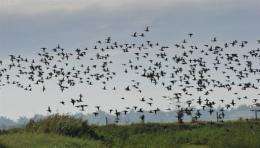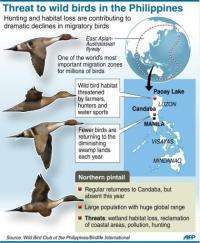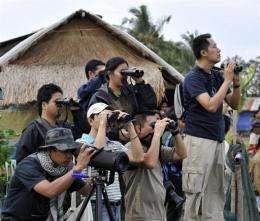Birds vanishing in the Philippines

The number of birds flying south to important wintering grounds in the Philippines has fallen sharply this year, with experts saying the dramatic demise of wetlands and hunting are to blame.
Despite some harsh, cold weather across the Eurasian landmass, some waterbirds that usually migrate in huge flocks to the tropical islands have been completely absent, said Philippine-based Danish ornithologist Arne Jensen.
"The flyway populations of several waterbird species are in constant and dramatic decline," Jensen, who advises the Philippine government on species conservation, told AFP.
"Hence the urgent need to establish real and well-managed, hunting-free waterbird sanctuaries along the migratory flyways."
Candaba, a swamp two hours' drive north of Manila that has long been used as a pit stop by hundreds of species as they fly staggering distances between the Arctic Circle and Australia, appears emblematic of the downfall.
Jensen said that bird watchers routinely counted 100,000 ducks at Candaba in the 1980s as they stopped there for a rest while traversing the East Asian-Australasian flyway.

But volunteers recorded just 8,725 waterbirds and 41 species during the annual census last weekend, Wild Bird Club of the Philippines president Michael Lu told AFP at Candaba at the end of the count.
Northern pintails, common pochards, and green-winged teals were absent, and just one tufted duck was seen, while numbers for northern shovellers shrank and only garganeys were easily seen along with resident Philippine ducks.
Lu said the number of waterbirds counted at Candaba was down from more than 11,000 last year.
"The main threat is hunting," said Lu, amid occasional loud bangs that were apparently gunfire or firecrackers set off by local residents seeking to flush out the birds.
But Lu also pointed to the dramatic shrinkage in the size of the swamp over the past 50 years as the region was converted into farmland, mainly rice fields.
The swamp two generations ago covered 27,000 hectares (66,690 acres), but it is now just 77 hectares -- or less than one percent of its original size -- according to figures provided by Lu, Jensen and the local government.
Hunters, farmers, and watersports also threaten Paoay Lake, another wild bird habitat in the far north of the Philippines that is close to southern China.
The lake lacks surface plant life after the late dictator Ferdinand Marcos ordered the water lilies removed so he could jetski from his lakeside mansion, while a former local official used to shoot ducks there, Lu said.

Since the water lily purge, water levels have continued to drop as farmers siphoned off water to irrigate farmland, while poor residents around the lake cut down trees, which they burnt to sell as charcoal, local bird watchers said.
The government has banned hunting of ducks on the lake, but things could still get worse with plans for a wakeboarding park, Lu said.
In the annual Paoay bird census this month, fewer than 700 waterbirds were counted compared with more than a thousand the previous year, said Elsie Nolasco, an official at the local environment ministry office.
The scenarios at the Paoay and Candaba wetlands are a microcosm of the general state around Asia, said Carlo Custodio, head of the coastal and marine management office at the Philippines' environment ministry.
"If you look down the coasts from China, South Korea, Japan, Malaysia, Indonesia, Singapore and down to Australia, you can see fast economic development, especially in China," Custodio told AFP.
"In the course of this development, habitats are destroyed as big segments of the populations move to the coasts. This also increases the chances that the birds will be hunted."
Environment group Wetlands International reported last year that waterbird populations in Asia were shrinking at a faster rate than anywhere else in the world because their habitats were being destroyed.
"The combination of rapid economical growth and weak conservation efforts (in Asia) appears to be lethal," Wetlands International said.
(c) 2011 AFP















